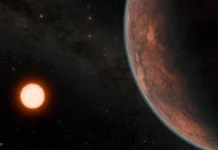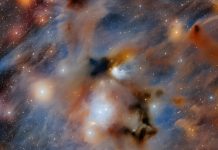
The giant outer planets haven’t always been in their current position. Uranus and Neptune for example are thought to have wandered through the outer Solar System to their current orbital position.
On the way, they accumulated icy, comet-like objects.
A new piece of research suggests as many as three kilomerer-sized objects crashed into them every hour increasing their mass. Not only would it increase the mass but it would enrich their atmospheres.
Uranus and Neptune are the two outermost planets in our Solar System. They differ from Jupiter and Saturn and share a number of characteristics based upon their composition.
Atmospheres rich in ammonia and methane ice and also volumes of water distinguish them from the the other gas giants.
Both have a distinctive blue hue to them, due to their composition but Uranus is unique for its extreme axial tilt of 98 degrees. Observed from afar, it seems to orbit the Sun on its side.
Neptune has wind speeds in excess of almost 2,000 kilometres.
Observe the Solar System today and it seems a largely calm place but the Nice model (named after the location of the Cote d’Azure Observatory in Nice, France where it was developed) suggests the giant planets migrated from an initial location into their present position, long after the protoplanetary disk had dissipated.
The idea became popular when it became clear that very long periods of time were required for Uranus and Neptune to form in their current location.
The model proposes that all the gas giants; Jupiter through to Neptune began their lives between 5 and 20 astronomical units from the Sun (one astronomical unit is equivalent to the average distance between Sun and Earth.) By comparison, Neptune is now at 30 astronomical units from Sun but some sort of catastrophic, chaotic event caused the planets to migrate out to their current positions.
The simulations run by the team from the University of California suggests that it’s even possible that Neptune started out closer to the Sun than Uranus. The higher mass of Neptune seems to suggest this may be the case.
Running through the simulations, the team estimate the amount of accretion on the planetesimals as they migrated out.
The team announce that the ice giants seem to undergo bombardment from icy materials at an astonishing rate.
The simulations showed that the extreme bombardment could have lasted for up to a million years with accretion rates of up to 3 planetesimals with a 1km radius every hour! This rate however seems to vary whether it is Uranus or Neptune and whether they switch position.
In the simulations where Uranus is furthest from the Sun, both accrete at the same position, at between 22 and 26 astronomical units. Where Uranus is nearer to the Sun Neptune seems to offer some sort of shield and accretes the majority of planetesimals.
It seems for now, the exact rates of accretion are still yet to be determined but we do know that the Solar System is far from peaceful and stable.
Over many millions of years, the landscape of the Solar System has changed. It is fair to say that it will change again as the Sun ages but thankfully we are a few billion years off this yet.
Written by Mark Thompson/Universe Today.



